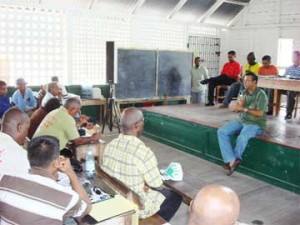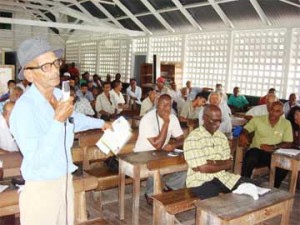Rice farmers have been promised approximately $800 million in support from the government in the wake of the recent price drop on the world market.

Minister of Agriculture Robert Persaud, at a meeting on Saturday hosted by the Guyana Rice Development Board (GRDB) in collaboration with the Rice Producers Association (RPA), told farmers that the government intended to provide support in various forms for the next crop.
The slashing of the export commission on rice, a 40 percent cut in the prices at which fertilizer is bought, and an arrangement for the provision of seed paddy are some of the avenues the Agriculture Ministry has taken to provide support to the industry, a Government Information Agency (GINA) release issued on Saturday said.
According to GINA, the Windsor Forest, West Demerara meeting between the Ministry and the rice bodies was held in an attempt to make rice farmers “aware of the realities on the world market with respect to pricing and other related issues”.
Many countries have been removing previously imposed bans on rice exports, GINA said, and countries such as India, Vietnam and Thailand are supplying more rice to the international market. Thus, prices have dropped by 35 percent.
Farmers, according to GINA, were advised that trends and patterns needed to be looked at for accurate predictions. The prices that are currently offered are higher than the 2006/2007 level when they dropped to a point where the production cost was higher.
Faced with growing dissatisfaction over prices being offered by rice millers for paddy, the Guyana Rice Producers’ Association (RPA) on March 4 had urged farmers to consider the effects of the “global crisis” on pricing.
RPA General Secretary Dharamkumar Seeraj had told a news conference that the Association, the GRDB and the Ministry of Agriculture would be meeting with millers, who have not yet quoted prices for the year, to look at the issue. Two meetings, inclusive of last week’s, have been held thus far to address the issue.
The RPA announcement came after a group calling itself the RPA Action Committee told Stabroek News that many farmers are unable to “break even” as the production cost per acre has increased and millers are offering between $2,500 and $3,000 for a bag of paddy. Increasing production costs and decreasing prices have since been a worry for farmers, most of who had loans to service.

However, at Saturday’s meeting Persaud assured farmers that the banking sector will fully support them as well as millers. According to the Minister, ninety six percent of these stakeholders have honoured their loans under the GBTI-operated European Union (EU) credit facility. Therefore, he said, the sector “was upbeat about financing of investments even though there is a financial crisis being experienced” worldwide.
Meanwhile, GRDB General Manager Jagnarine Singh said that his organisation was looking at creating a rice corner in the newspapers so that farmers would be aware of the prices. This price index, the GINA release stated, will be offered by the board before the crop.
The Burma Rice Research station, Singh said, has boosted production by over four tons per hectare over the past few years and Region Three has eight field schools to aid in rice production. At the moment, two new lines are being tested, he said.
Further, advising farmers on the suitability of fertilizers, the GRDB General Manager said that his organisation could be contacted and the fertilizer could be tested. These tests are carried out in Miami and will cost farmers US$10.
Extension services are also available for Region Three. According to GINA, the region has two GRDB officials and four RPA officials providing services. Further, a facility at Burma will be built at a cost of $40M to further boost the services offered by GRDB.
GINA said that $39.4M will be spent on the capital works programme and approximately $156M will be spent this year on the construction of a new sluice at De Willem.
The capital works programme, GINA stated, includes construction of a koker at Northern Hog Island, construction of revetment at Tuschen, rehabilitation of the Philadelphia sideline dam and construction of a check panel at La Jalousie.
Some drainage tubes will also be installed in various parts of the region. For the current works programme, $206.8M will be spent on additional works such as the building of six bridges, excavation of six trenches, rehabilitation of 29 sluices and the bulldozing of 11 dams. Six excavators and two draglines are working in the region.
Chief Executive Officer of the National Drainage and Irrigation Authority (NDIA), Lionel Wordsworth, stated at the meeting on Saturday that drainage and irrigation works were being carried out in Region Three.
However, works have been affected by encumbrances and the Authority had to constantly deal with the issue of siltation.




